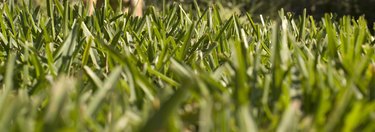
St. Augustine grass is a popular turf grass found in the Southeastern United States from Florida to the Gulf Coast of Texas. It tolerates modest shade but develops poorly in heavy shade. A healthy St. Augustine lawn will choke out weeds and other grass strains. The only way to plant St. Augustine is by plugs or sod. Fertilization after planting is critical to any new planting of St. Augustine grass. Subsequent fertilization should normally follow a seasonal schedule.
Late Winter and Early Spring
Video of the Day
Depending on how far south you are, your St. Augustine turf grass should get its first fertilizing in very late winter or early spring. This is when the grass is just starting to grow again. This is a good time to contact your agriculture extension service and have them test your soil. They will be able to tell you the specific Nitrogen, Phosphorus and Potassium (NPK) mixture of fertilizer you will need. If necessary, locate them through your state's Department of Agriculture.
Video of the Day
Spring and Early Summer
This is your best time to stop weeds. If your lawn was subject to weed problems last year, it is a good idea to make a preemptive strike with a preemptive herbicide. This is not a fertilizer as such, but anything that helps control weeds makes your fertilizer more effective. A late-spring fertilizer should provide a larger amount of nitrogen. Use the soil analysis as a guide for your proper NPK. This is also the time for Weed-and-Seed formulations but, be cautious about these treatments. Most are designed for weeding more than feeding.
Summer and Early Fall
The summer and early fall is St. Augustine's best growing period and fertilizing is not recommended. Unfortunately, it is also the period when those pesky little chinch bugs thrive. The best preventive medicine against chinch bugs is a healthy lawn. Left unchecked, chinch bugs can literally destroy an entire yard. Check your lawn's thatch. When it accumulates to over 1/2 inch, it is starting to harm your lawn. Contact a service that can vacuum and de-thatch your lawn.
Early Fall and Winter
Disease and weed problems can be minimized with a late fall fertilization. It is during the fall that your grass produces the deepest and largest roots. Fertilization of your St. Augustine grass in the late fall will maintain your lawn's healthy dark green appearance. This also gives your grass a head start for a healthy early spring growth. To keep your lawn attractive for the longest period, a Texas A&M Agrilife paper specifically recommends that St. Augustine lawns receive ". . . about 1 pound of nitrogen every 30 to 60 days from early spring through late fall."
Other Considerations
Your lawn depends on regular feedings, and one way to provide this is with "slow-release" fertilizers. This allows your lawn to experience less nutrient peaks and valleys. When fertilizing, try to use a spreader for even distribution. Fill the spreader while it is on the driveway, not the grass. This will eliminate the over-fertilizing that comes from inadvertent spills while loading the spreader.